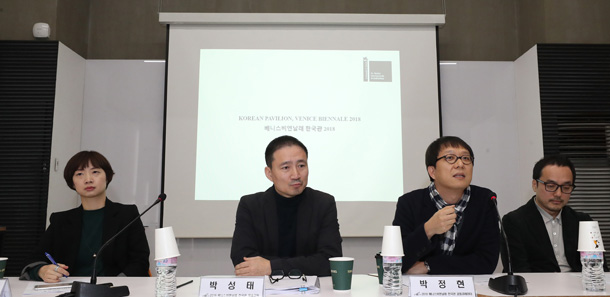Showing how Seoul became Seoul

The Arts Council Korea holds a press conference on March 21 announcing the theme of the Korean Pavilion at the 2018 Venice Biennale. From left are Chung Dah-young, Park Seong-tae (director), Park Jung-hyun and Choi Choon, explaining the features of the pavilion. [YONHAP]
The Arts Council Korea announced the theme of the Korean Pavilion March 21 at the Arko Art Center in central Seoul, disclosing what the Korean team has in store for the international arts festival, which will run May 26 through Nov. 25 on the theme of “Freespace.” The conference was attended by the art director for the pavilion Park Seong-tae and the three co-curators. Park Jung-hyun, Chung Dah-young and Choi Choon.
“Architecture in modern Korea has a very complex relationship with the state,” said Park Seong-tae. “The ideology infused by the state came in conflict with the progressive ideals of architects, the contradictory results of which gave birth to the foundations of the Seoul we see today. We wanted to look back at the history of the late 1960s and how the remnants of the past still linger in the city like a ghost, every time we try to do something.”
The pavilion will be divided into two main themes, “The Absent Archive” and “The Emergent Archive.” The two exhibits juxtapose two different timelines in history, which are set decades apart but still exist in the same space upon the same grounds.
“The Absent Archive” is an overview of four different projects led by the Korea Engineering Consultants Corporation (KECC), a group of the finest architects of the time including Kim Swoo-geun (1931-1986). With the four projects - the construction of the Sewoon Arcade in central Seoul in 1968; the 1968 Trade Fair in Guro, southern Seoul; Kim Swoo-geun’s 1968 Masterplan for Yeouido; and the Korean Pavilion at the 1970 Japan World Exposition - which were initiated by the conservative government and executed by creative architects. Two contradictory forces exist within their walls, according to Park.

Works by different artists and architects which will be put on exhibit. Clockwise from top left are works by archiects Kang Hyun-seok and Kim Gun-ho; curator Choi Choon; and architect duo Jeon Jin-hong and Choi Yu-ni of studio BARE. [ARTS COUNCIL KOREA]
“The Emergent Archive” features works by seven teams of architects and different genres of art, who will each present their own answers to the question of how we could build a future on decades-old foundations. The parallel exhibition of the past and present is the Korea Pavilion’s interpretation of “Freespace.”
“By looking back at Korea in the 1960s, we strive to move forward and offer our knowledge to the progression of the history of architecture,” said Park. The Korean Pavilion will hold its opening ceremony on May 24.
Meanwhile, the Seoul Metropolitan Government named Francisco Sanin, professor of architecture at Syracuse University, and architect Lim Jae-yong co-directors for the 2019 Seoul Biennale of Architecture and Urbanism, on Friday. The event, the second of its kind after the first was held in 2017, will take place for two months from September 2019.
“TheSeoul Biennale of Architecture and Urbanism holds great significance in that Seoul serves as the discourse channel for the city and architecture,” said Seung Hyo-sang, Head of Steering Committee of the Seoul Biennale of Architecture and Urbanism.
BY YOON SO-YEON [yoon.soyeon@joongang.co.kr]










with the Korea JoongAng Daily
To write comments, please log in to one of the accounts.
Standards Board Policy (0/250자)